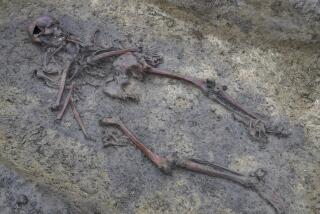Rescuers Reach Airmen’s Bodies Frozen in Time
- Share via
REYKJAVIK, Iceland — After battling icy cold and unsettling tremors on an Icelandic glacier, rescuers reached the bodies of four airmen preserved in the ice for almost 60 years.
Frozen in time alongside the victims were poignant reminders of young lives cut short: a flying jacket, a toothbrush, a birthday watch.
A team including Britain’s Royal Air Force, Iceland’s mountain rescue and coast guard and an American Black Hawk helicopter reached the crash site this week.
Amid the wreckage, scattered over a 165-foot radius, team members found the bodies of the men, who died when their Fairey Battle bomber crashed into a snow-covered mountain in May 1941.
“It was a very emotional time for everybody up there,” said Nick Barr, the Royal Air Force expedition leader. “To hear the shuddering of the glacier and to see the wreckage made you feel that there, but for the grace of God, go I. There was a feeling of helplessness in that four men had died there.”
The airmen’s relatives will attend a memorial service to be held Sunday at the Fossfogur Commonwealth war cemetery in Reykjavik, where the four are to be buried.
The wreckage was revealed only last year after unusually warm weather melted some of the ice on the glacial peak between Eyjafjordur fjord and Oxnadalur in northern Iceland.
The 16-person rescue party endured temperatures of 14 degrees and ice tremors within the glacier to reach the site 700 feet below the summit of the 4,000-foot mountain.
“As we got closer, one or two things were instantly recognizable: a tail wheel upside down and sticking out of the ice, a bit of wing spar and a propeller with three 7-foot blades,” Barr said.
“My first thought was amazement at the devastation of such a crash. The wreckage was in thousands of bits, from aircraft washers to 12-foot pieces.”
Many items remained frozen into the ice, and the teams used ice picks and chisels to dig out cans of corned beef, boot polish, two Browning Mark II machine guns complete with 200 rounds of ammunition, and parts of a fuel meter and other instruments.
But it was the personal possessions that gave the find poignancy: a flying jacket and boots, a Flying Officer’s rank braid, a toothbrush, razors, a wallet containing Icelandic coins--bent by the impact of the crash--and a Swiss watch inscribed “A. Round from Dad. 14.2.34.”
The watch had been given to the pilot of the doomed plane, Flying Officer Arthur Round, two days after his 19th birthday.
Some of the personal items recovered could be given to the relatives of the victims, but equipment such as the machine guns are likely to be placed in an Icelandic museum.
Before the expedition left the site Wednesday, rescuers recited the Lord’s Prayer in English and Icelandic.
With Round, a native of Wellington, New Zealand, were three Britons: radio operator Reginald Hopkins, 21, of Southampton; Flight Sgt. Keith Garrett, 22, of Worksop; and Pilot Officer Henry Talbot, 24, of North Shields.
“It does bring the reality and tragedy straight home to you,” said Royal Air Force Sgt. Ian Ellis, a member of the search team. “You try to treat the bodies with the respect you hope members of your own family would treat you.”
The crash site was discovered after a 20-year search by Icelandic historian Ordur Geirsson, who had been inspired by tales of Round’s reputed aviation skills.
The cause of the crash has remained a mystery, but Fairey Battle aircraft were practically obsolete by the start of World War II. Underpowered and underarmed, they were used mainly to train pilots and to fly reconnaissance missions.
More to Read
Sign up for Essential California
The most important California stories and recommendations in your inbox every morning.
You may occasionally receive promotional content from the Los Angeles Times.













